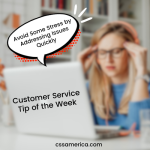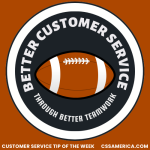
The new leader joins the organization, and she decides she wants to question everything. She wants employees to question everything. Why have we always done it this way? Why do we continue to do it that way? Is this the best way to work?
Sometimes it’s a great management initiative because it forces us to question the validity in doing things in the future a certain way just because we’ve done them that way in the past. It can be a beneficial leadership tactic because it gets the organization thinking in a continuous improvement mindset.
But when it comes to customer service, what’s the question? That depends on our goal. If we’re an organization that is focused on delighting the customer or wowing the customer or amazing the customer or creating a Disney-like experience, you would ask: Are employees focused on delighting the customer when they are greeted? Does our speed of service make the customer go WOW? Is the physical environment where the service is delivered creating an amazing feel for the experience?
Let’s say your goal is to keep every customer. Then you would ask: Are we personalizing every communication with our customer? Are we proactively touching base with every customer to have an ongoing sense of their feelings about us? Are we asking enough questions to truly understand why they would stay, why they would go? Are we asking the right questions to truly understand their needs so we can specifically match up our resources with their needs?
What if your goal is simply to deliver a consistent, accurate, and timely service experience? First of all, “simply” is probably not the best word to use. Creating an experience that is consistent, accurate, and timely is anything but simple. But let’s discuss what questions you would ask: How are we ensuring that – no matter who delivers a service – it is done in the same manner? How do we ensure and track accuracy? How do we define “timely” or have a customer define timely, and how are we meeting the timeliness goal?
To be continuous improvement-oriented, to try to foster positive change, consider questioning everything. But before you start questioning, first understand what your goal is as an organization, and let that drive what you ask.
Question everything, but first know what’s the question.
Signup for FREE Tips! Contact Us More Resources for You Visit Our Home Page





















